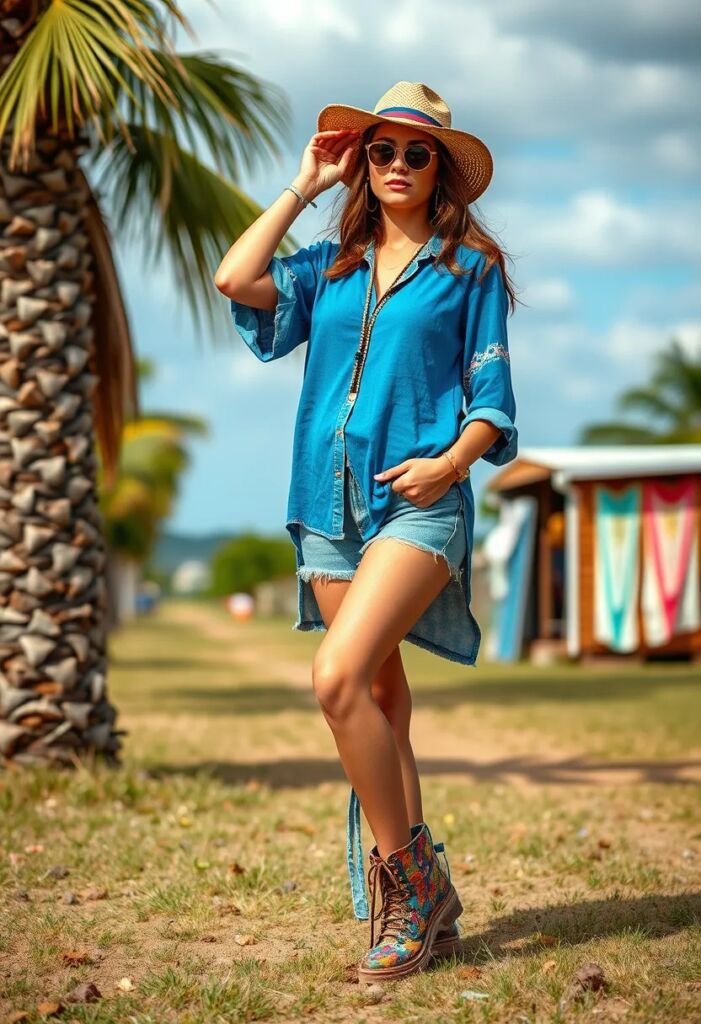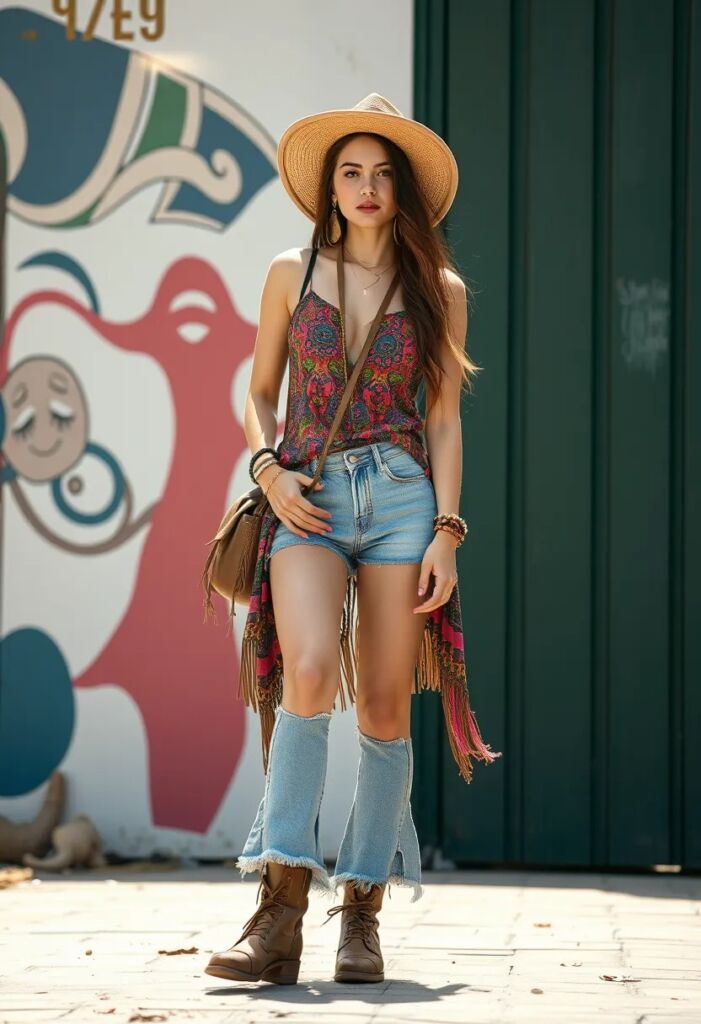Hippie style, a cultural phenomenon that emerged in the 1960s, is more than just a fashion trend. It represents a movement that challenged societal norms and promoted peace, love, and freedom. The hippie movement was a reaction to the rigid conformity of the 1950s, and it continues to influence fashion and culture today. From flowing dresses to tie-dye shirts, the hippie aesthetic is both vibrant and eclectic. In this article, we will explore the origins, key elements, and modern interpretations of the hippie style.

What Exactly is a Hippie?
A hippie, or hippy, is a person who embraces a lifestyle rooted in peace, love, and freedom. The term “hippie” emerged in the 1960s, a time of great social and cultural upheaval. Hippies are known for their colourful fashion, deep philosophical beliefs, and a strong sense of community.

The Origins of Hippie Style
The roots of the hippie style can be traced back to the countercultural movements of the 1960s, particularly in the United States. Cities like San Francisco and New York became hubs for young people seeking to break free from traditional values. The Haight-Ashbury district in San Francisco, known as the epicentre of the hippie movement, was where the “Summer of Love” took place in 1967. This period was marked by a surge in creativity, music, and fashion that reflected the ideals of the hippie community.
The Cultural Impact
The hippie movement was not just about fashion; it was a cultural revolution. It emphasized the importance of individuality, non-conformity, and a return to nature. Hippies were known for their love of music, especially genres like rock, folk, and psychedelic. Iconic bands like the Grateful Dead, Jefferson Airplane, and the Beatles were central to the hippie ethos, and their music often served as a soundtrack to the movement.
Key Fashion Elements
The hippie style is characterized by its free-spirited and bohemian elements. Some of the key fashion items include:

- Flowing Dresses and Skirts: Made from lightweight fabrics like cotton and silk, these garments often featured floral prints and vibrant colours.
- Bell-Bottom Pants: These wide-legged trousers were a staple of the hippie wardrobe, often paired with peasant blouses or tie-dye shirts.
- Headbands and Bandanas: These are used to keep hair out of the face, and these accessories also add a touch of bohemian flair.
- Jewellery: Hippies often wore natural materials like wood, beads, and feathers. Statement pieces such as large necklaces and bracelets were common.
- Footwear: Sandals, especially those made from leather, were popular. Some hippies went barefoot to connect more closely with nature.
The Influence of Global Cultures
The hippie style drew inspiration from a variety of global cultures, particularly those from India, Africa, and the Middle East. These influences can be seen in the use of:
- Indian Saris and Scarves: Often worn as wraps or head coverings, these textiles added a touch of exoticism.
- African Prints: Bold patterns and vibrant colours were incorporated into clothing and accessories.
- Middle Eastern Embellishments: Beads, embroidery, and intricate designs were common.
The Role of Music
Music played a crucial role in shaping the hippie style. Concerts and music festivals, such as Woodstock in 1969, were not just about the music but also about the community and the shared values of the attendees. The fashion at these events was a reflection of the hippie ethos, with attendees often dressing in elaborate, colorful outfits.
The Fashion Icons
Several fashion icons emerged from the hippie movement, each contributing to the style in their own unique way:
- Janis Joplin: Known for her powerful voice and bold fashion choices, Joplin often wore fringed leather jackets, flowing skirts, and heavy jewellery.
- Jimi Hendrix: His stage presence was as captivating as his music, and he often wore bright, patterned shirts and wide-brimmed hats.
- Patty Hearst: Although her involvement in the movement was controversial, her style, characterized by long, flowing hair and bohemian dresses, was emblematic of the hippie aesthetic.
Modern Interpretations of Hippie Style
While the original hippie movement may have faded, its influence on fashion is still evident today. Many contemporary designers and fashion brands draw inspiration from the hippie style, which has been reinterpreted and adapted by contemporary designers. Here are some modern takes on hippie fashion:

- Boho Chic: This style combines the free-spirited elements of hippie fashion with a more polished, modern aesthetic. Think flowy dresses, fringe details, and natural fabrics.
- Festival Fashion: Modern music festivals, such as Coachella, have embraced a hippie-inspired look. Attendees often wear crop tops, cut-off shorts, and floral crowns.
- Sustainable Fashion: The hippie movement’s emphasis on natural and sustainable living has influenced the modern sustainable fashion movement. Brands now offer eco-friendly clothing made from organic materials.
The Revival of Tie-Dye
Tie-dye, a hallmark of hippie fashion, has seen a resurgence in recent years. This technique involves twisting, folding, or crumpling fabric and securing it with string or rubber bands before dyeing. The result is a unique, colourful pattern. Tie-dye has become a popular DIY project, allowing people to create their own one-of-a-kind pieces.
The Impact on Contemporary Designers
Many contemporary designers have been inspired by the hippie aesthetic. Some notable examples include:
- Dolce & Gabbana: Known for their bold prints and intricate designs, Dolce & Gabbana often incorporates elements of hippie style into their collections.
- Gucci: Under the creative direction of Alessandro Michele, Gucci has embraced a bohemian aesthetic, featuring flowing silhouettes and vibrant colours.
- Free People: This brand is known for its boho-chic style, offering a wide range of hippie-inspired clothing and accessories.
The Hippie Lifestyle
Hippie style is not just about the clothes; it’s also about the lifestyle. The hippie movement emphasized:
- Connection to Nature: Many hippies sought to live in harmony with the environment, often opting for a simpler, more sustainable way of life.
- Spirituality: Hippies often explored various spiritual practices, including meditation, yoga, and the use of natural remedies.
- Community: The hippie movement was built on a sense of community and shared values. Communes and collective living arrangements were common, fostering a sense of belonging and support.
The Modern Hippie
While the original hippie movement may have been a product of its time, the spirit of the movement lives on. Modern hippies, often referred to as “neo-hippies,” continue to embrace the values of peace, love, and environmental consciousness. They may not dress in the same way as their 1960s counterparts, but they carry forward the ideals of the movement.
The Future of Hippie Style
As we look to the future, it’s clear that the hippie style will continue to evolve. The emphasis on sustainability and individuality will likely play a significant role in shaping the next generation of hippie fashion. Here are some trends to watch for:
- Eco-Friendly Materials: The use of sustainable and eco-friendly materials will become even more prevalent.
- Digital Hippie: The rise of digital fashion and virtual reality may lead to new, innovative ways to express hippie style.
- Global Fusion: As the world becomes more interconnected, we can expect to see more global influences in hippie fashion.
Pro Tips for Embracing Hippie Style
If you’re looking to incorporate hippie style into your wardrobe, here are some pro tips:
- Start with the Basics: Invest in a few key pieces, such as a flowing dress, a pair of bell-bottom pants, and a fringed jacket.
- Mix and Match: Don’t be afraid to mix different patterns and textures. Hippie style is all about individuality and creativity.
- Accessories: Add a touch of bohemian flair with headbands, scarves, and jewellery made from natural materials.
- DIY Projects: Try your hand at tie-dye or embroidery to create unique, personalized pieces.
Hippie Style in the Digital Age
The digital age has brought new opportunities for expressing hippie style. Social media platforms like Instagram and Pinterest are filled with inspiration for hippie fashion. Bloggers and influencers have become modern-day fashion icons, sharing their interpretations of the hippie aesthetic with a global audience.

The Role of Social Media
Social media has played a significant role in the revival of the hippie style. Platforms like Instagram have made it easier than ever to discover new trends and connect with like-minded individuals. Here are some popular hashtags to explore:
- #BohoChic
- #HippieStyle
- #FestivalFashion
- #TieDye
Online Shopping
The internet has also made it easier to shop for hippie-inspired clothing and accessories. Here are some popular online stores to check out:
Conclusion
Hippie style is a testament to the power of individuality and creativity. From its origins in the 1960s countercultural movement to its modern interpretations, hippie fashion continues to inspire and influence. Whether you’re looking to embrace a bohemian lifestyle or simply add_a touch_of_bohemian_chic_to_your_wardrobe, the_hippie_aesthetic_offers_endless_possibilities. So, let your hair down, put on your favourite flowing dress, and embrace the spirit of the hippie movement.
By embracing the spirit of the hippie movement, you can create a look that is both timeless and modern. Whether you’re attending a music festival or simply looking to add a touch of bohemian flair to your everyday style, the possibilities are endless. So, go ahead and let your creativity shine!
